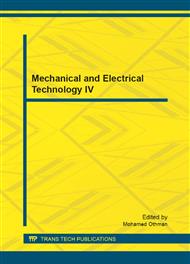[1]
Q. Wei and R. G. Harley, in: Power Quality and Dynamic Performance Improvement of Wind Farms Using a STATCOM, in Power Electronics Specialists Conference, PESC 2007, IEEE Conference, pp.1832-1838, (2007).
DOI: 10.1109/pesc.2007.4342280
Google Scholar
[2]
M. G. Molina and P. E. Mercado, in: Comparative evaluation of performance of a STATCOM and SSSC both integrated with SMES for controlling the power system frequency, Transmission and Distribution Conference and Exposition: Latin America, IEEE/PES, pp.535-541, (2004).
DOI: 10.1109/tdc.2004.1432436
Google Scholar
[3]
S. Yuanzhang, H. Shan, R. Ortega and M. Galaz, in: Influence of transfer conductance on power system stability with excitation control, Power Engineering Society General Meeting, IEEE Conference, p.6, (2006).
DOI: 10.1109/pes.2006.1709069
Google Scholar
[4]
M. G. Molina, P. E. Mercado and E. H. Watanabe, in: Dynamic Performance of a Static Synchronous Compensator with Superconducting Magnetic Energy Storage, in 36th Power Electronics Specialists Conference, PESC '05, IEEE Conference, pp.224-230, (2005).
DOI: 10.1109/pesc.2005.1581628
Google Scholar
[5]
M. Januszewski, J. Machowski and J. W. Bialek, in: Application of the direct Lyapunov method to improve damping of power swings by control of UPFC, Generation, Transmission and Distribution, IEE Proceedings, volume 151, pp.252-260, (2004).
DOI: 10.1049/ip-gtd:20040054
Google Scholar
[6]
A. Esmaieli, S. A. N. Niaki, A. Tajfar and H. Nademi, in: Unified modeling of UPFC-SMES in power system application, in Industrial Electronics and Applications, ICIEA 3rd, IEEE Conference, pp.2051-2056, (2008).
DOI: 10.1109/iciea.2008.4582881
Google Scholar
[7]
P. Bhatt, R. Roy and S. P. Ghoshal, in: Coordinated control of SSSC and SMES in competitive electricity market for load frequency control, in Probabilistic Methods Applied to Power Systems - PMAPS 11th, IEEE International Conference, pp.42-47, (2010).
DOI: 10.1109/pmaps.2010.5529009
Google Scholar
[8]
M. A. Abido, A. T. Al-Awami and Y. L. Abdel-Magid, in: Simultaneous design of damping controllers and internal controllers of a unified power flow controller, in Power Engineering Society General Meeting, IEEE Conference, p.8, (2006).
DOI: 10.1109/pes.2006.1709297
Google Scholar
[9]
M. Ghandhari, G. Andersson and I. A. Hiskens, in: Control Lyapunov functions for controllable series devices, IEEE Transactions on Power Systems, volume 16, pp.689-694, (2001).
DOI: 10.1109/59.962414
Google Scholar
[10]
F. Zhou, G. Joos, C. Abbey and J. Lianwei, in: Optimal state control for CSI superconducting magnetic energy storage system, in Power System Technology – PowerCon 2004, volume 2, pp.1072-1077, (2004).
DOI: 10.1109/icpst.2004.1460160
Google Scholar


